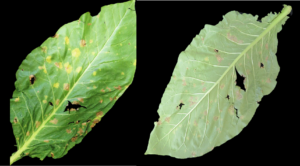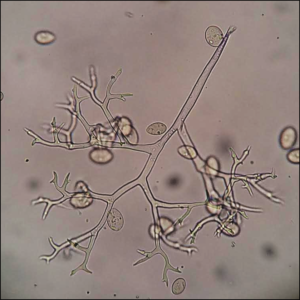Tobacco Blue Mold Confirmed in NC
go.ncsu.edu/readext?476967
en Español / em Português
El inglés es el idioma de control de esta página. En la medida en que haya algún conflicto entre la traducción al inglés y la traducción, el inglés prevalece.
Al hacer clic en el enlace de traducción se activa un servicio de traducción gratuito para convertir la página al español. Al igual que con cualquier traducción por Internet, la conversión no es sensible al contexto y puede que no traduzca el texto en su significado original. NC State Extension no garantiza la exactitud del texto traducido. Por favor, tenga en cuenta que algunas aplicaciones y/o servicios pueden no funcionar como se espera cuando se traducen.
Português
Inglês é o idioma de controle desta página. Na medida que haja algum conflito entre o texto original em Inglês e a tradução, o Inglês prevalece.
Ao clicar no link de tradução, um serviço gratuito de tradução será ativado para converter a página para o Português. Como em qualquer tradução pela internet, a conversão não é sensivel ao contexto e pode não ocorrer a tradução para o significado orginal. O serviço de Extensão da Carolina do Norte (NC State Extension) não garante a exatidão do texto traduzido. Por favor, observe que algumas funções ou serviços podem não funcionar como esperado após a tradução.
English
English is the controlling language of this page. To the extent there is any conflict between the English text and the translation, English controls.
Clicking on the translation link activates a free translation service to convert the page to Spanish. As with any Internet translation, the conversion is not context-sensitive and may not translate the text to its original meaning. NC State Extension does not guarantee the accuracy of the translated text. Please note that some applications and/or services may not function as expected when translated.
Collapse ▲Tobacco blue mold was confirmed (July 11, 2017) in commercial tobacco in Caswell County, North Carolina by the Plant Disease and Insect Clinic at NCSU.
Symptoms were consistent with blue mold, including chlorotic lesions on the tobacco leaf and bluish-gray sporangiospores on the underside of the lesions (Fig 1). Structures of Peronospora tabacina were found on leaves using microscopy (Fig 2).

Figure 1. Yellow lesions on surface of leaves, and blue-gray hyphae and spores found on the lower leaves of affected tobacco
Growers in this region should scout for symptoms. Risk of new infections decreases significantly after topping, but infection may still occur. If disease is present, an application of a fungicide with oomycete activity, such as Quadris, Revus, Forum, or Presidio, may help reduce disease. To see rates of fungicides, the 2017 North Carolina Agricultural Chemicals Manual has recommendations for blue mold control
Presently, this is an isolated field, and the disease is favored by cool, wet weather. If you suspect a blue mold infection, contact your county extension agent or submit a sample to the Plant Disease and Insect Clinic for confirmation.



